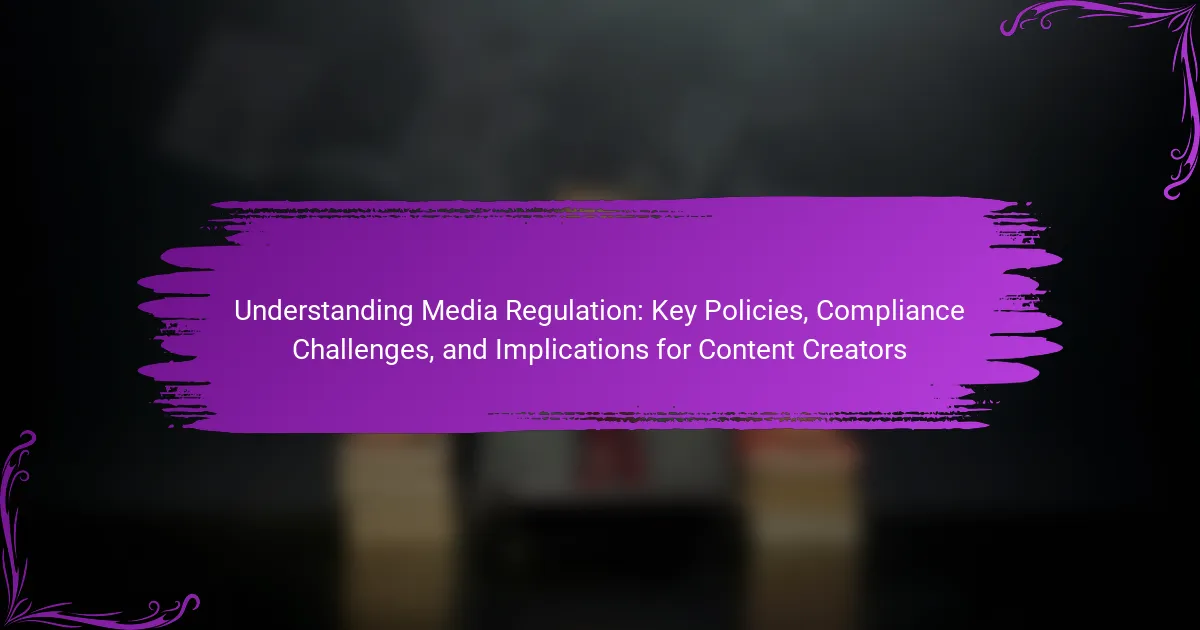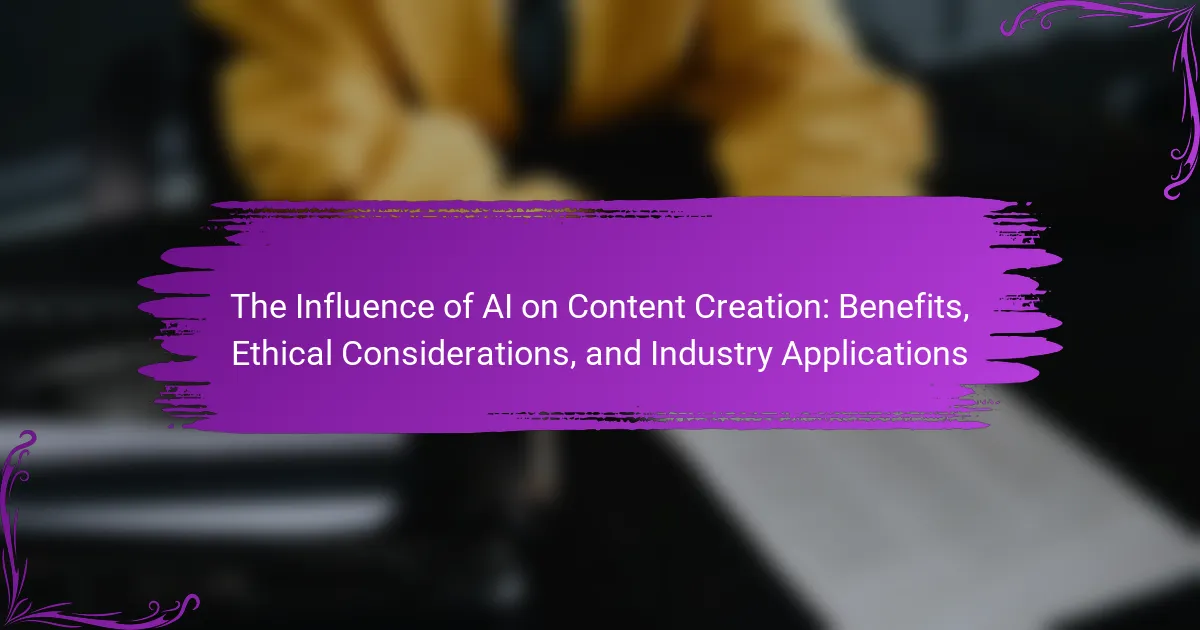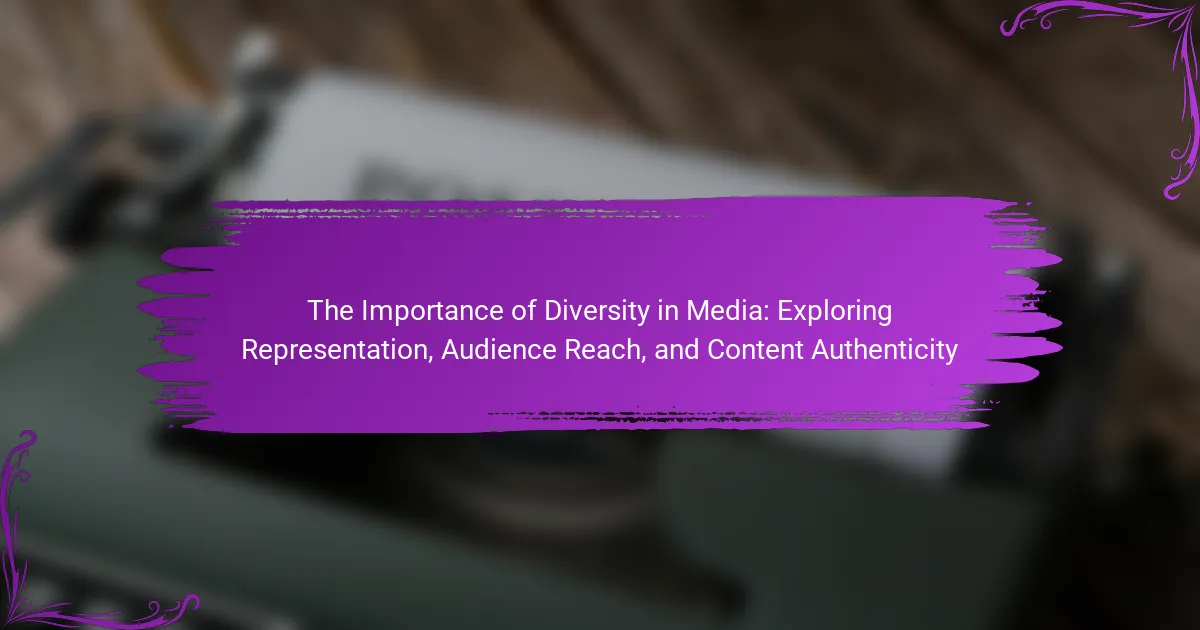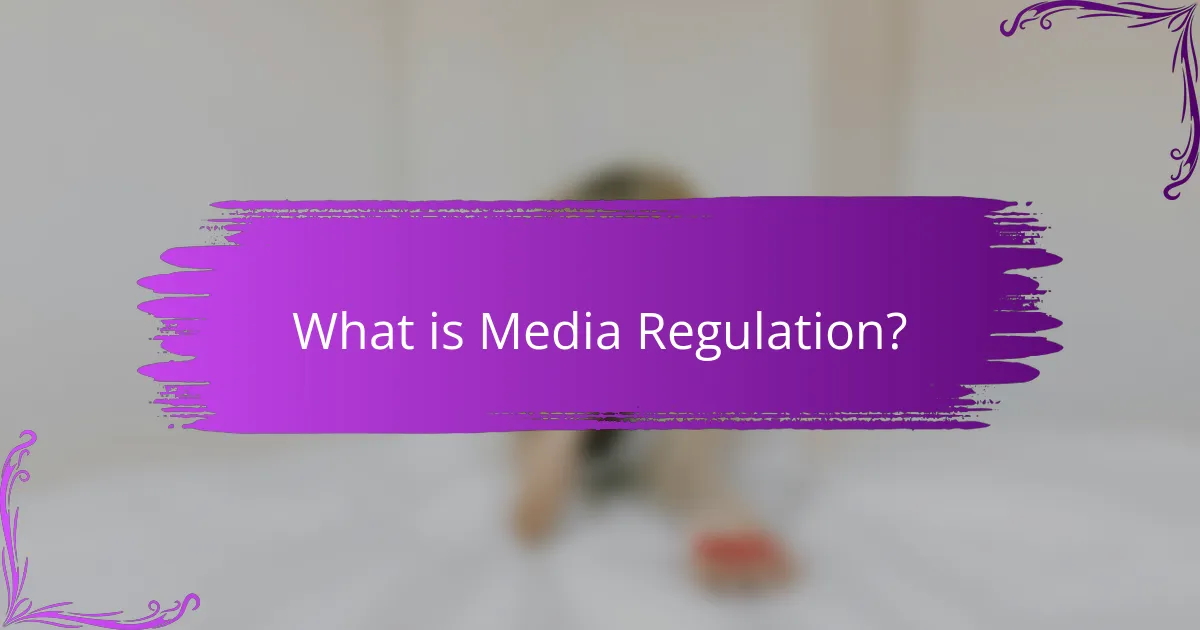
What is Media Regulation?
Media regulation refers to the set of rules and guidelines governing the operation of media organizations. It aims to ensure fairness, accountability, and transparency in media practices. Media regulation often addresses issues like content standards, ownership restrictions, and consumer protection. Regulatory bodies, such as the Federal Communications Commission (FCC) in the United States, enforce these rules. Compliance with media regulation is essential for maintaining public trust. Violations can lead to penalties, including fines or revocation of licenses. Overall, media regulation shapes how content creators operate within the industry.
How does Media Regulation impact content creation?
Media regulation significantly impacts content creation by establishing guidelines that govern what can be produced and shared. These regulations ensure that content adheres to legal and ethical standards. Compliance with these regulations can shape the themes, language, and formats used in media. For instance, regulations may restrict the portrayal of violence or hate speech. Additionally, media regulation can influence the diversity of voices in content creation. Regulations often promote inclusivity and representation, affecting who gets to tell stories. Furthermore, content creators must navigate licensing and copyright laws, which can limit how they use existing materials. Overall, media regulation acts as both a framework for protection and a potential constraint on creativity.
What are the fundamental principles of Media Regulation?
The fundamental principles of media regulation include protection of public interest, promotion of diversity, and ensuring accountability. Protection of public interest ensures that media serves the needs of society. Promotion of diversity encourages a variety of viewpoints and prevents monopolies. Ensuring accountability holds media organizations responsible for their content. These principles aim to foster a fair and democratic media landscape. They are supported by legal frameworks and regulatory bodies worldwide. For instance, the Federal Communications Commission (FCC) in the United States enforces these principles to maintain an equitable media environment.
How does Media Regulation differ across countries?
Media regulation varies significantly across countries due to differing political, cultural, and legal frameworks. In democratic nations, regulations often emphasize freedom of speech and press, allowing a wide range of content. For instance, the United States prioritizes First Amendment rights, leading to minimal restrictions on media content. Conversely, authoritarian regimes impose strict controls on media to suppress dissent and maintain power. Countries like China enforce stringent censorship laws, limiting access to information. Additionally, European countries often have comprehensive media laws that include protections for privacy and anti-discrimination measures. These diverse approaches reflect each country’s unique societal values and governance structures.
What are the key policies governing Media Regulation?
Key policies governing media regulation include content standards, licensing requirements, and anti-monopoly laws. Content standards ensure that media output adheres to ethical guidelines and legal requirements. Licensing requirements regulate who can operate media outlets and under what conditions. Anti-monopoly laws prevent concentration of media ownership, promoting diversity in viewpoints. These policies aim to protect consumers and maintain a fair media landscape. For instance, the Federal Communications Commission (FCC) in the United States enforces these regulations to uphold public interest.
Which organizations are responsible for enforcing Media Regulation?
The organizations responsible for enforcing media regulation include the Federal Communications Commission (FCC) in the United States. The FCC oversees broadcasting, telecommunications, and satellite communications. In the United Kingdom, Ofcom is the regulatory authority for the communications sector. Ofcom regulates television, radio, and internet services. The European Union has various regulatory bodies, such as the European Commission, which sets media policy across member states. Additionally, national regulatory authorities exist in many countries to enforce local media laws. These organizations ensure compliance with laws related to content, advertising, and broadcasting standards.
What are the major laws and regulations affecting media content?
The major laws and regulations affecting media content include the Communications Act, copyright laws, and defamation laws. The Communications Act governs broadcasting and telecommunications in the United States. Copyright laws protect original works, ensuring creators have rights over their content. Defamation laws address false statements that harm an individual’s reputation. Additionally, privacy laws regulate the collection and use of personal information in media. These laws are enforced by agencies such as the Federal Communications Commission (FCC) and the U.S. Copyright Office. Compliance with these regulations is crucial for content creators to avoid legal repercussions.
Why is compliance important for content creators?
Compliance is important for content creators to ensure they adhere to legal and ethical standards. It protects them from potential legal repercussions, such as fines or lawsuits. Compliance also builds trust with audiences, enhancing credibility and brand reputation. Furthermore, it ensures the content aligns with platform guidelines, which can prevent account suspensions or bans. For example, in 2020, the Federal Trade Commission penalized influencers for failing to disclose paid partnerships. This illustrates the tangible consequences of non-compliance. Overall, compliance fosters a responsible content creation environment that benefits both creators and their audiences.
What are the potential consequences of non-compliance?
Non-compliance with media regulations can lead to significant legal and financial repercussions. Entities may face hefty fines imposed by regulatory bodies. For instance, the Federal Communications Commission (FCC) can levy penalties amounting to thousands of dollars per violation. Additionally, non-compliance can result in legal actions from affected parties, leading to costly litigation. Content creators risk losing their licenses or permits to operate, which can halt their business activities. Furthermore, reputational damage can occur, affecting audience trust and engagement. Studies show that companies with compliance issues often see a decline in market value. Overall, the consequences of non-compliance can severely impact an entity’s operations and profitability.
How can content creators ensure compliance with regulations?
Content creators can ensure compliance with regulations by understanding relevant laws and guidelines. They should stay informed about federal, state, and local regulations that impact their content. Regularly reviewing industry standards is also essential. Engaging with legal experts can provide clarity on complex issues. Implementing best practices for transparency, such as disclosing sponsorships, is crucial. Adhering to copyright laws protects against infringement claims. Utilizing content management tools can help track compliance effectively. Regular audits of content can identify potential regulatory issues before they arise.
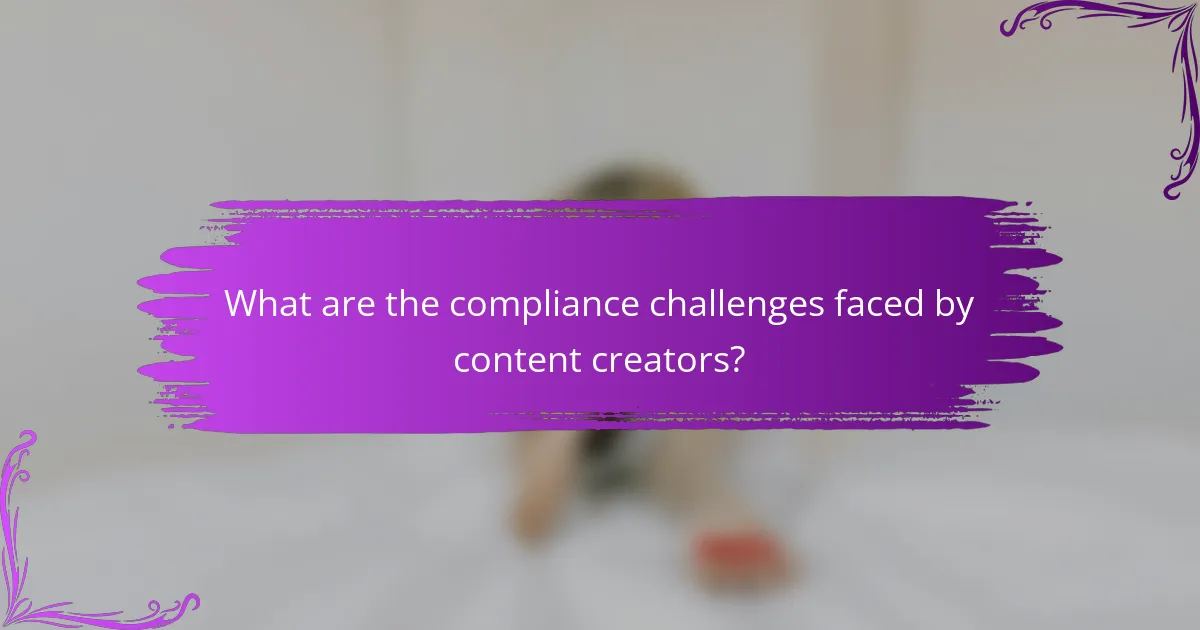
What are the compliance challenges faced by content creators?
Content creators face several compliance challenges, primarily related to copyright laws, data privacy regulations, and platform guidelines. Copyright infringement can occur when creators use protected material without permission. Data privacy regulations, such as GDPR, require creators to handle user data responsibly. Additionally, platform-specific guidelines can impose restrictions on content types and monetization practices. Non-compliance can lead to legal repercussions and loss of platform access. In 2022, over 60% of creators reported concerns regarding copyright issues, highlighting the prevalence of this challenge.
What common obstacles do content creators encounter with Media Regulation?
Content creators often face challenges such as unclear regulations. These regulations can vary significantly across different regions. This inconsistency leads to confusion about compliance requirements. Additionally, content creators struggle with the rapid pace of regulatory changes. Keeping up with these changes can be resource-intensive. Financial constraints also pose a significant obstacle. Many creators lack the budget for legal consultations. Furthermore, there is the risk of censorship. Content can be removed or restricted due to regulatory compliance issues. These obstacles collectively hinder the creative process and limit content diversity.
How do changes in regulations affect content strategies?
Changes in regulations significantly impact content strategies by altering the guidelines for content creation and distribution. Compliance with new regulations can require content creators to adjust their messaging and formats. For instance, stricter advertising regulations may limit promotional language or imagery. Additionally, changes in data privacy laws can affect how content is personalized for audiences. Content strategies must also adapt to avoid penalties and maintain audience trust. Research shows that 70% of marketers report adjusting strategies due to regulatory changes. This adaptability is crucial for long-term success in a dynamic regulatory environment.
What resources are available to help navigate compliance challenges?
Resources available to help navigate compliance challenges include regulatory agencies, legal consultants, and industry associations. Regulatory agencies provide guidelines and updates on compliance requirements. Legal consultants offer specialized advice tailored to specific industries. Industry associations often create resources and training programs for members. Additionally, online platforms provide access to compliance management tools. These tools help organizations track and manage compliance obligations. Many organizations also publish white papers and case studies on best practices. These resources collectively enhance understanding of compliance landscapes.
How do content creators adapt to evolving Media Regulation?
Content creators adapt to evolving media regulation by staying informed about new laws and guidelines. They regularly review updates from regulatory bodies. Many attend workshops and webinars focused on compliance. Content creators often consult legal experts for clarification on complex regulations. They adjust their content strategies to align with these regulations. This includes modifying language and visuals to avoid potential violations. Some creators use technology to monitor compliance automatically. Engaging with industry groups also helps them share best practices and insights.
What strategies can be employed to stay informed about regulatory changes?
Subscribe to regulatory newsletters and industry publications. These sources often provide timely updates on changes. Attend webinars and conferences focused on regulatory issues. Networking with professionals can also yield valuable insights. Utilize regulatory tracking tools and software. These tools can automate updates based on specific criteria. Follow relevant government agencies on social media. Agencies frequently post updates and announcements. Join professional organizations that focus on media regulation. They often share resources and updates with members. Lastly, engage with legal experts in the field. Their expertise can help interpret complex changes.
How can collaboration with legal experts assist in compliance?
Collaboration with legal experts can significantly enhance compliance efforts. Legal experts provide specialized knowledge of regulations and laws relevant to media. They help organizations understand complex legal frameworks. This understanding aids in identifying compliance gaps. Legal experts also assist in developing compliance strategies tailored to specific needs. Their insights can mitigate risks associated with non-compliance. Furthermore, legal experts can conduct audits to ensure ongoing adherence to regulations. This proactive approach protects organizations from potential legal penalties.
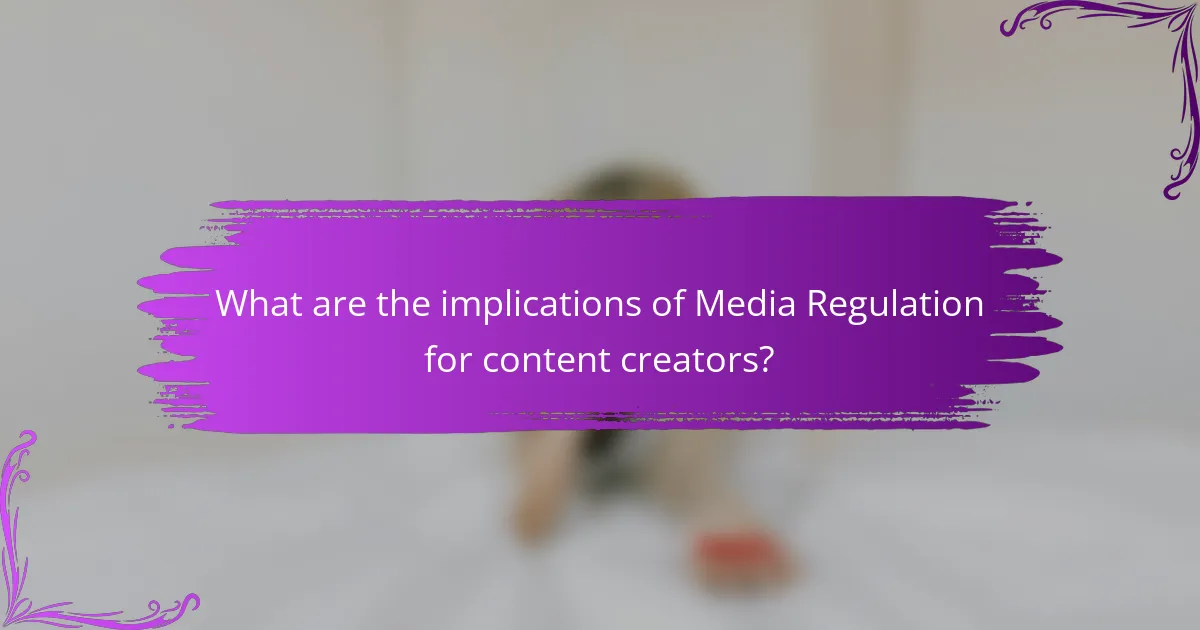
What are the implications of Media Regulation for content creators?
Media regulation significantly impacts content creators by establishing guidelines for content production and distribution. These regulations aim to ensure compliance with legal and ethical standards. Content creators must navigate restrictions on copyright, hate speech, and misinformation. Failure to comply can result in fines or content removal. Regulations can also affect monetization opportunities and audience reach. For instance, platforms may restrict content that does not align with regulatory standards. Additionally, regulations can promote transparency and accountability in content creation. Overall, media regulation shapes the landscape in which content creators operate, influencing their creative freedom and business viability.
How does Media Regulation influence content quality and diversity?
Media regulation significantly influences content quality and diversity by establishing standards and guidelines for creators. These regulations often mandate accuracy, fairness, and accountability in reporting. As a result, content produced under these frameworks tends to be more reliable and informative.
Regulations can also encourage diverse viewpoints by requiring representation of various demographics and perspectives. For instance, laws in many countries promote inclusivity in media representation. Furthermore, regulatory bodies may impose penalties for non-compliance, incentivizing content creators to adhere to quality standards.
Research indicates that countries with stringent media regulations often see higher content quality metrics. For example, the European Union’s Audiovisual Media Services Directive aims to ensure a diverse media landscape. This directive has led to increased funding for independent productions, enhancing content variety.
Overall, media regulation plays a crucial role in shaping both the quality and diversity of the content available to audiences.
What role does Media Regulation play in protecting intellectual property?
Media regulation plays a crucial role in protecting intellectual property by establishing legal frameworks. These frameworks define ownership rights and usage permissions for creative works. Regulations help prevent unauthorized use or reproduction of intellectual property. They also provide mechanisms for enforcement against infringement. For instance, copyright laws are enforced through regulatory bodies. These laws allow creators to seek legal recourse for violations. Additionally, media regulation promotes fair competition and innovation. By protecting intellectual property, regulation encourages investment in creative industries. This ultimately supports economic growth and cultural diversity.
How can Media Regulation foster innovation in content creation?
Media regulation can foster innovation in content creation by establishing clear guidelines that encourage creativity. These regulations can provide a framework that protects intellectual property while promoting diverse content. By ensuring fair competition, media regulation can stimulate new ideas and formats. For instance, regulations that support emerging technologies can lead to innovative content delivery methods. Additionally, funding incentives from regulatory bodies can support new projects and experimental content. Countries with supportive media policies, such as tax credits for digital content, often see increased innovation in their media sectors. This demonstrates that effective regulation can create a conducive environment for creative growth.
What best practices should content creators follow to navigate Media Regulation?
Content creators should adhere to best practices for navigating media regulation. First, they must familiarize themselves with relevant laws and guidelines. This includes understanding copyright, defamation, and privacy regulations. Second, creators should ensure transparency in their content. Disclosing sponsorships and affiliations helps maintain trust and compliance. Third, they should regularly review and update their content strategies. Media regulations can evolve, making it essential to stay informed. Fourth, creators must engage with legal professionals when necessary. Consulting experts can clarify complex regulations and prevent potential violations. Lastly, creators should prioritize audience safety and well-being. This includes avoiding harmful content and promoting responsible messaging. Following these practices can lead to compliance and foster a positive content creation environment.
How can content creators build a compliance-focused culture?
Content creators can build a compliance-focused culture by establishing clear guidelines and policies. These guidelines should align with legal regulations and industry standards. Training sessions on compliance should be regularly conducted for all team members. Content creators must promote transparency in their processes and decision-making. Regular audits can help identify compliance gaps and areas for improvement. Encouraging open communication fosters a culture where compliance is prioritized. Recognizing and rewarding compliance efforts can motivate adherence to standards. Research shows that organizations with strong compliance cultures experience lower risks and enhanced reputations.
What tools and technologies can assist in ensuring regulatory compliance?
Compliance management software assists in ensuring regulatory compliance. These tools help organizations track regulations and manage compliance processes. Document management systems store and organize compliance-related documents effectively. Risk management software identifies and mitigates compliance risks proactively. Automated reporting tools generate compliance reports efficiently and accurately. Training management systems ensure employees are educated on compliance requirements. Data privacy solutions help organizations comply with data protection regulations. Audit management software streamlines the audit process for compliance verification. Each of these tools plays a crucial role in maintaining compliance with regulatory standards.
Media regulation is the framework of rules and guidelines that govern media organizations, ensuring fairness, accountability, and transparency in content creation. This article explores key aspects of media regulation, including its impact on content creation, fundamental principles, and variations across countries. It addresses compliance challenges faced by content creators, the importance of adhering to regulations, and the potential consequences of non-compliance. Additionally, the article highlights best practices for navigating media regulation and the role of regulatory bodies in enforcing policies that protect intellectual property and foster innovation in content creation.
